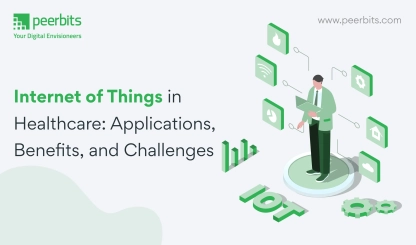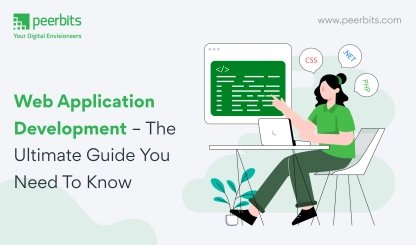The Internet of Things (IoT) is helping industries globally with smarter operations, improved productivity, and better customer experiences. As IoT continues to develop, its impact is evident across sectors like healthcare, retail, and manufacturing.
According to Statista, the Industrial IoT market is projected to reach USD 275.70 billion by 2025, with a CAGR of 13.34%, reaching USD 454.90 billion by 2029. This rapid growth highlights the need for businesses to adopt IoT to stay competitive.
In this blog, we will explore the role of IoT in various industries, highlighting its benefits and applications, and why holding IoT is important for business success.
Key benefits of IoT across industries
IoT development is driving advancements across various sectors by automating processes, optimizing resources, and improving customer experiences.
Below are some key benefits explained in detail:
1. Enhanced efficiency
IoT automates repetitive tasks, streamlines workflows, and reduces manual intervention. This optimization lets businesses focus on core activities while achieving faster and more reliable outcomes.
2. Cost savings
IoT helps identify areas of waste and inefficiency by monitoring resources in real time. This leads to reduced energy consumption, lower operational expenses, and better allocation of resources, saving money in the long run.
3. Data-driven decision-making
IoT collects real-time data from connected devices, offering actionable insights. These insights help businesses analyze trends, predict outcomes, and make well-informed decisions with greater accuracy.
4. Improved customer experiences
IoT-powered solutions enable personalized services, from tailored product recommendations to smart home devices. Businesses can deliver a more engaging and satisfying customer experience by understanding user needs.
5. Increased safety and security
IoT devices monitor environments and detect potential risks, ensuring quick responses to issues like equipment malfunctions or security breaches. This reduces risks and safeguards people and assets.
IoT applications in healthcare
The healthcare sector is rapidly adopting IoT to revolutionize patient care and improve infrastructure. According to Fortune Business Insights, the global Internet of Things market is projected to grow from USD 175.61 billion in 2024 to an impressive USD 822.54 billion by 2032, with a CAGR of 21.3%.
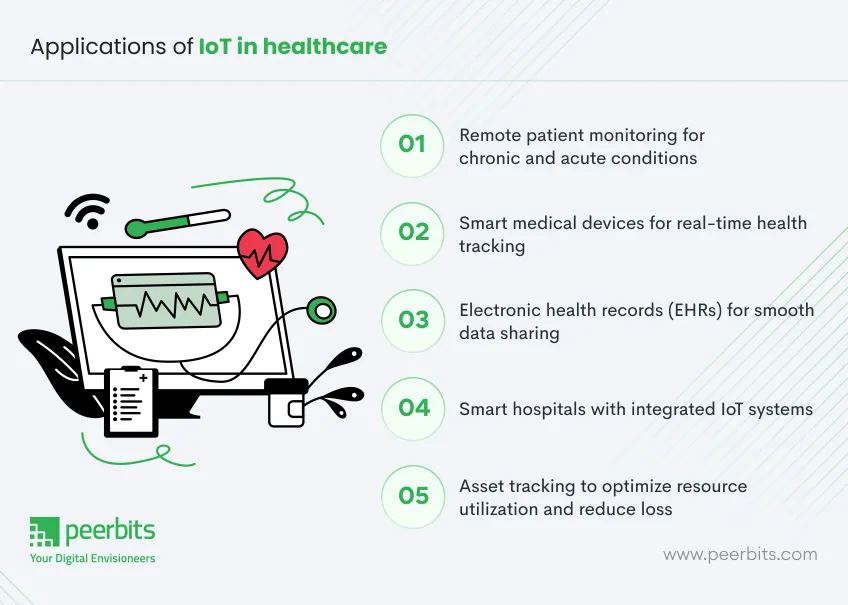
1. Remote patient monitoring for chronic and acute conditions
IoT-powered wearable devices track patient health parameters in real-time. This technology minimizes hospital visits and ensures timely interventions for conditions such as cardiovascular diseases and diabetes.
2. Smart medical devices for real-time health tracking
Connected devices like smart inhalers and glucose monitors deliver accurate data to healthcare providers, helping adjust treatments and improve patient outcomes.
3. Electronic health records (EHRs) for smooth data sharing
IoT simplifies integrating patient information into electronic health records and makes sure that doctors have access to accurate and complete medical histories. This supports continuity of care across different facilities.
4. Smart hospitals with integrated IoT systems
Hospitals with IoT automate processes like patient monitoring, bed management, and equipment usage. These systems reduce human error and improve operational efficiency, improving patient satisfaction.
5. Asset tracking to optimize resource utilization and reduce loss
IoT solutions for asset tracking ensure that critical medical tools and equipment are always accessible. This reduces delays caused by misplaced items and optimizes resource management within healthcare facilities.
The applications of IoT in healthcare promises to improve patient outcomes and redefine how healthcare systems operate. This makes it more responsive and efficient for all.
IoT applications in retail
The integration of IoT into retail is redefining how businesses connect with customers and helps with their operations. As per Allied Market Research, the global IoT in retail market is forecasted to hit $177.90 billion by 2031, highlighting its growing influence in the industry.
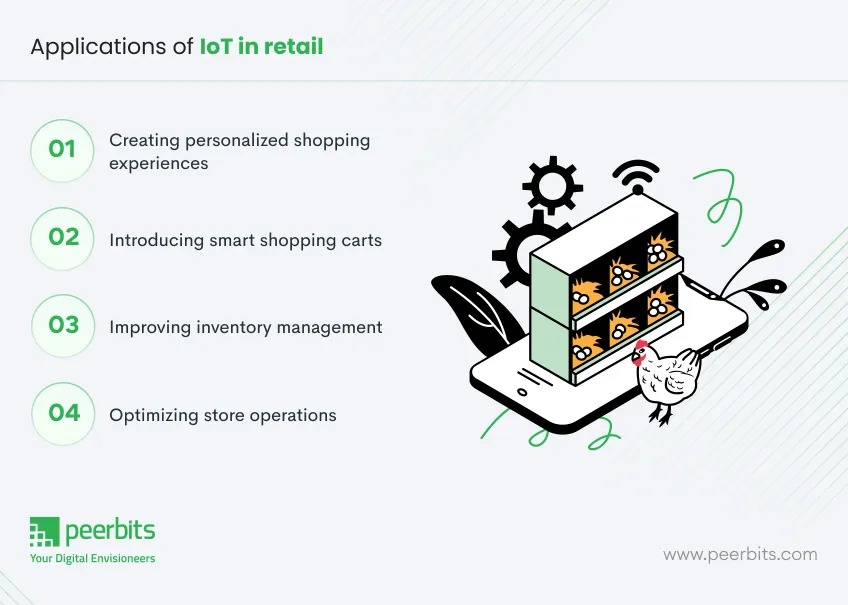
1. Creating personalized shopping experiences
IoT-based analytics help retailers understand customer preferences, letting for customized recommendations and offers that boost satisfaction and loyalty. Retailers can improve experiences, making customers feel valued by using past purchase data and browsing patterns.
2. Introducing smart shopping carts
With IoT carts, customers can enjoy faster shopping experiences as the carts track items automatically, cutting down checkout times. These smart carts can also offer real-time promotions or discounts based on the items in the cart, providing an additional layer of personalization.
3. Improving inventory management
Real-time inventory updates through IoT systems let retailers efficiently manage stock levels, preventing shortages and ensuring smooth operations. Automated alerts notify when stock is running low, allowing for timely restocking and reducing the chances of overstocking.
4. Optimizing store operations
IoT solutions automate energy consumption and improve security measures by managing lighting, HVAC systems, and surveillance, reducing costs and improving safety. The data generated by these systems can be analyzed to continuously refine operations, making stores more efficient and responsive to changing conditions.
IoT helps retailers to stay ahead in a competitive marketplace by setting new benchmarks in efficiency and customer satisfaction.
IoT applications in manufacturing
The adoption of IoT in manufacturing is developing how industries operate, smarter and more efficient production processes. According to Mordor Intelligence, the IoT market in manufacturing is expected to grow from USD 490 billion in 2025 to USD 1510 billion by 2030.
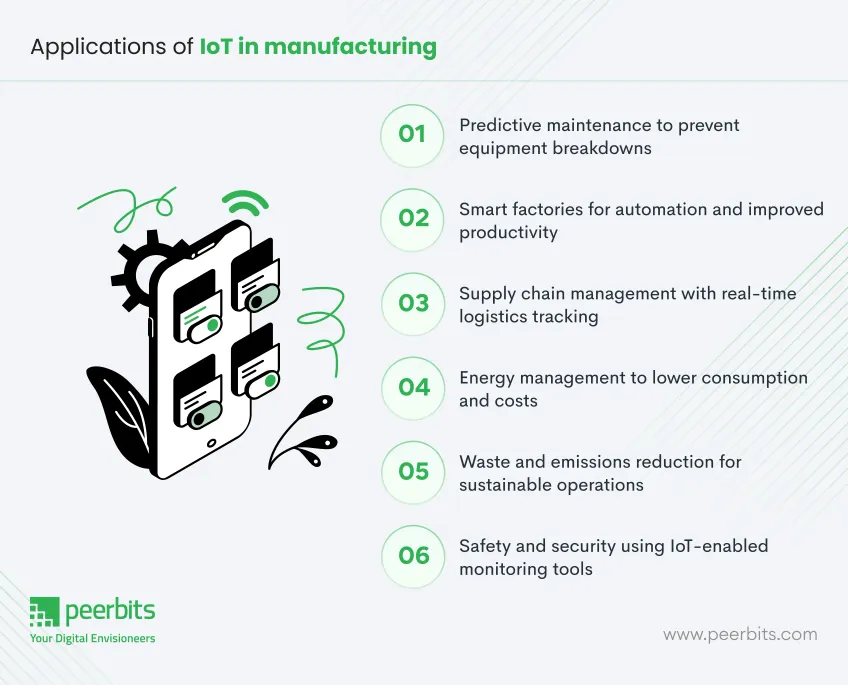
1. Predictive maintenance to prevent equipment breakdowns
Real-time monitoring of machinery through IoT sensors helps identify potential issues early, reducing downtime and costly repairs. Businesses can increase the lifespan of equipment and avoid unplanned halts in production by addressing problems before they escalate.
2. Smart factories for automation and improved productivity
Integrated IoT systems in factories helps with automation, smooth communication between devices, and optimized production workflows. These systems can dynamically adjust processes based on real-time data, increasing flexibility and responsiveness to changes in demand or production requirements.
3. Supply chain management with real-time logistics tracking
IoT-powered tracking systems improve visibility, ensuring timely deliveries and minimizing delays and disruptions in the supply chain. Real-time updates allow for better planning and responsiveness, ensuring that goods reach their destinations without unnecessary detours or hold-ups.
4. Energy management to lower consumption and costs
IoT solutions provide actionable insights into energy use, helping manufacturers cut energy expenses and operate more efficiently. The ability to monitor energy consumption in real-time let adjustments to equipment or operations, further optimizing resource use.
5. Waste and emissions reduction for sustainable operations
IoT helps businesses reduce their environmental impact and comply with sustainability goals by monitoring and managing waste. Detecting inefficiencies, such as excess energy consumption or overproduction can help businesses in adopting practices that minimize waste and reduce carbon footprints.
6. Safety and security using IoT-enabled monitoring tools
IoT applications improve workplace safety by identifying risks, improving compliance, and protecting employees. Through continuous monitoring of environments and processes, risks can be spotted early, ensuring a safer work environment for everyone.
With IoT driving innovation, manufacturing is moving toward greater efficiency, sustainability, and safety, paving the way for a more connected industrial future.
IoT applications in energy and utilities
The global IoT in utilities market is growing rapidly as smart technologies find increasing application in energy, water, and gas sectors. Grand View Research predicts this market will grow at an annual rate of 10.7% from 2024 to 2030.
Similarly, the IoT in energy sector is expected to reach $35.2 billion by 2025, showcasing its expanding impact. These developments bring innovative solutions that enhance resource management and sustainability efforts.
1. Smart grid management for efficient energy distribution
IoT-based smart grids balance electricity generation and distribution in real time, aligning supply with demand. Sensors and analytics within these grids identify faults, prevent outages, and improve energy delivery to homes and businesses.
2. Energy-efficient buildings with automated controls
Buildings equipped with IoT systems reduce energy consumption by automating heating, cooling, and lighting. These systems adjust dynamically to environmental conditions, optimizing energy usage and lowering operational expenses.
3. Renewable energy integration through IoT systems
IoT technologies monitor and manage renewable energy sources like solar and wind, facilitating their integration into the grid. This supports a stable energy supply while maximizing green energy use.
4. Water resource management to minimize waste
IoT devices track water systems, detecting leaks and optimizing distribution to prevent waste. These solutions also improve irrigation practices, conserving water in agricultural and urban areas.
5. Carbon emissions monitoring and reduction
IoT sensors measure emissions across utility and industrial operations, helping businesses pinpoint inefficiencies and adopt cleaner technologies. These tools are instrumental in meeting environmental standards and cutting carbon footprints.
IoT is transforming the energy and utilities sectors, promoting greater efficiency and sustainability while laying the groundwork for future progress in these industries.

IoT applications in transportation and logistics
The IoT in transportation market is set for significant expansion, with projections estimating it will reach $495.57 billion by 2030. This growth reflects the widespread adoption of IoT based solutions in logistics, public transit, and autonomous mobility.
1. Smarter logistics management with connected fleets
Fleet management systems powered by IoT offer real-time vehicle tracking and monitoring. They support timely deliveries, reduce idle time, and boost overall productivity in logistics operations.
2. Connected vehicles for diagnostics and performance tracking
IoT sensors in vehicles monitor metrics such as engine health and fuel consumption. This real-time data helps businesses schedule maintenance proactively, reducing downtime and keeping vehicles operational.
3. Enhanced public transportation through IoT data analytics
IoT solutions in public transit analyze passenger data to optimize schedules and routes. This improves service reliability, reduces wait times, and enhances the commuting experience.
4. Route optimization for efficient deliveries and reduced fuel consumption
IoT navigation systems evaluate traffic patterns and road conditions to suggest the most efficient routes. This minimizes delivery times, lowers fuel usage, and cuts operational costs.
5. Autonomous vehicles shaping the future of transportation
IoT supports autonomous vehicles by connecting them to live traffic updates, weather information, and smart infrastructure. These advancements pave the way for safer and more efficient transportation systems.
With the transportation industry evolving rapidly, IoT for logistics continues to drive groundbreaking advancements, setting the stage for a more efficient, sustainable, and connected future.
IoT applications in agriculture
IoT is revolutionizing agriculture, transforming traditional farming into a high-tech, data-driven industry. Farmers can achieve better efficiency, productivity, and sustainability by integrating IoT technologies.
1. Smart farming solutions for better productivity
IoT-powered devices offer automated systems to optimize irrigation, fertilization, and harvesting. These solutions help farmers save resources while boosting crop yields and ensuring consistent output.
2. Precision agriculture with real-time monitoring of crops and soil
IoT sensors provide detailed insights into soil moisture, nutrient levels, and crop health. This data helps with precise interventions, ensuring healthier crops and minimizing resource wastage.
3. Livestock monitoring for animal health and movement tracking
Wearable IoT devices track the health, location, and activity of livestock. Farmers can ensure better herd management and prevent the spread of diseases through timely action.
4. Drones and robotics for automation in seeding and spraying
IoT-integrated drones and robots automate tasks like seeding, spraying, and monitoring. This reduces manual labor and enhances precision, saving time and resources for large-scale farming.
5. Environmental monitoring for weather, pests, and soil conditions
IoT systems monitor environmental factors such as weather patterns, pest activity, and soil quality. This helps farmers protect crops and adapt to changing conditions effectively.
6. Predictive maintenance of farming equipment
IoT applications track the performance of machinery, alerting farmers to potential breakdowns. Early interventions ensure machinery longevity and uninterrupted farming operations, saving repair costs.
IoT for agriculture is creating smarter and more sustainable farming practices, addressing global food demands while conserving resources.
Emerging trends and challenges in IoT
The IoT market is rapidly developing, carried by technological innovations while simultaneously facing key challenges that must be addressed for further growth.
1. Innovations shaping IoT adoption
The integration of advanced technologies is significantly improving IoT capabilities, leading to smarter solutions.
Integration of AI and machine learning into IoT
AI and machine learning allow IoT devices to process data more effectively, enhancing automation, decision-making, and predictive functions across industries.
Role of edge computing in reducing latency
Edge computing reduces latency by processing data closer to its source, which is vital for real-time IoT applications in sectors like transportation and healthcare.
2. Addressing challenges
Despite the opportunities, IoT adoption faces challenges that must be overcome for widespread success.
Data privacy and security concerns
With the large amounts of data generated by IoT devices, ensuring privacy and security remains a top priority. Effective encryption and secure data protocols are necessary to protect sensitive information.
Scalability and standardization hurdles
As IoT ecosystems grow, the lack of standardized protocols and scalable solutions leads to integration issues and inefficiencies. Achieving interoperability among diverse devices is essential for fully realizing IoT’s potential.
Conclusion
IoT has developed industries by making processes smoother, improving decisions, and offering solutions to various challenges. It plays an important role in areas like healthcare, agriculture, manufacturing, and transportation.
As IoT continues to evolve, combining it with technologies like AI and edge computing will bring more possibilities. Overcoming challenges like security and scalability will cover the way for IoT to bring even greater benefits to businesses and society.

FAQ's
IoT optimizes processes like energy consumption, asset tracking, and inventory management. Businesses can save costs by reducing waste, improving resource allocation, and automating routine tasks.
While IoT benefits nearly all sectors, industries like manufacturing, healthcare, agriculture, transportation, and retail see the most significant impact due to its ability to enhance efficiency and provide real-time insights.
Yes, regulatory compliance for data privacy, security standards, and cross-border data transfer can be complex, especially in industries like healthcare and finance where sensitive data is involved.
IoT can be integrated with legacy systems using middleware solutions and APIs. However, companies often face challenges like compatibility issues and high upgrade costs during the transition.
IoT projects require expertise in areas like sensor technology, cloud computing, data analytics, cybersecurity, and machine learning. Collaboration between IT teams and industry specialists is crucial.
Yes, many IoT solutions are scalable and customizable, making them affordable for SMEs. Cloud-based platforms and modular IoT systems allow smaller businesses to start small and expand over time.

